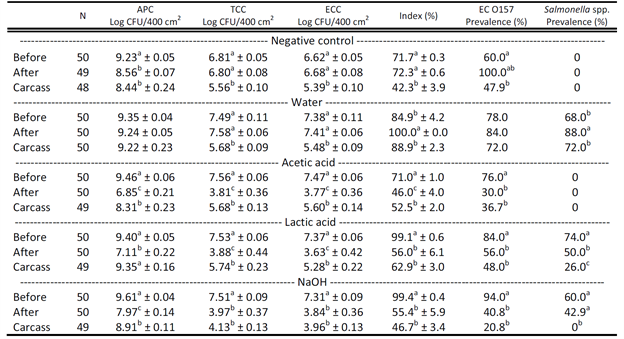Project Summary
Evaluating the Efficacy of a Number of Compounds to Reduce E. coli O157 Load on Hides as to Pattern Lines Just Prior to Dressing
- Principle Investigator(s):
- Mohammad Koohmaraie1, John Scanga1, Andy Buschow1, Jonathan Kauk1, Timothy Burk1, Bijan Koohmaraie, Mike De La Zerda1, A. Mohseni Motlagh2, and Mansour Samadpour1
- Institution(s):
- 1IEH Laboratories & Consulting Group
- 2American Food Group
- Completion Date:
- 2010
Background
There are plenty of data that shows the efficacy of hide interventions in reducing the E. coli O157 load on hides as well as in the resultant trim. However, for a variety of reasons, the vast majority of the plants are unable to include a hide wash cabinet in their food safety systems. The challenge is to come up with an effective system that reduces the transfer of E. coli O157 during dressing. The objective of this proposal is to evaluate the efficacy of a number of compounds that have shown to be efficacious toward hide E. coli O157 when used in the plant on the pattern lines prior to dressing.
The objective of this study was to evaluate the efficacy of acetic acid, lactic acid, and bromized hot water as applied to pattern lines to reduce the E. coli O157:H7 load.
Methodology
Samples from 247 beef carcasses were collected prior to intervention application, following intervention application and from dressed carcasses. Samples were analyzed for the presence of E. coli O157, Salmonella and microbial indicators (Aerobic Plate Count [APC], Total Colony Count [TCC] and Ecological Carrying Capacity [ECC]). The following hide-on interventions were evaluated; 1) Negative Control, 2) Water Control (60°C, 2.0 bars), 3) Lactic Acid (6.4%, 30°C, 2.0 bars), 4) Acetic Acid (4.75%, 30°C, 2.0 bars) and 4) Sodium Hydroxide (2.68%, 12° C, 2.0 bars). Data analysis and reporting are currently underway.
Findings
Acetic acid reduced (P < 0.05) APC, TCC, ECC, and E. coli O157 (there were no detectable Salmonella before treatment to allow evaluation). Lactic acid reduced (P < 0.05) APC, TCC, ECC, E. coli O157 and Salmonella. Sodium hydroxide reduced (P < 0.05) APC, TCC, ECC, and E. coli O157. Overall results indicate that the use of any of these chemicals will results in reductions in microbial population from beef hide. Comparison analysis of the data suggests that NaOH was more effective at controlling coliform bacteria and potential pathogens compared to the other treatments.
IMPLICATIONS
It is now clearly shown that hide is the major source of E. coli O157 in the red meat supply. Similarly, it is clearly established that hide intervention is perhaps the most effective intervention to control E. coli O157. However, a very few percentage of U.S. beef processing plants have hide wash interventions or have the capability to install a hide wash system. Since dressing is the most significant that determines how much of the hides bacteria is transferred onto the carcass, any effective intervention that reduces the hide load regardless of the location of application should reduce the level of E. coli O157 that is transferred from hide onto the carcass and eventually the prevalence in raw ground beef materials. In this project the researchers evaluated the efficacy of a number of common and proven antimicrobial as applied to pattern lines to reduce the level of E. coli O157:H7 and Salmonella on beef carcass after hide removal. These results provide the beef processing companies that for whatever reason, cannot use an automated hide wash system, an alternative and effective hide intervention procedure.

Table 1. Least squares means ± standard error for aerobic plate counts (APC), total coliform counts (TCC), and generic E. coli biotype I counts (ECC) values (Log CFU/400 cm2), pathogen PCR Index (%) and prevalence of E. coli O157 and Salmonella from the surface of hides and dressed carcasses from cattle whose hides were treated with nothing (Negative Control), water (60° C, 2.0 atm), acetic acid (4.8%, 30°C, 2.0 atm), lactic acid (6.4%, 30° C, 2.0 atm) and NaOH (2.68%, 12° C, 2.0 atm). Samples were collected from 3 harvest process locations (Before, After and Carcass), with intervention application occurring between the Before and After sampling locations.